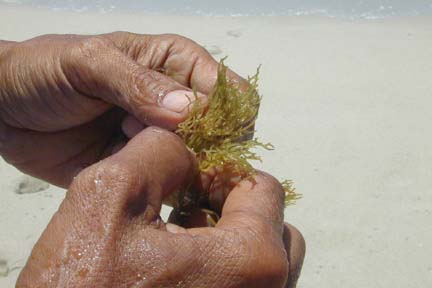
STAR-BULLETIN / 2000
Henry Chang Wo holds limu that he had just plucked from the ocean floor.
|
|
Ewa ban on limu
picking proposed
A state plan to limit seaweed
harvesting could assist efforts
to replenish the area
Closing an area of Ewa Beach to ogo limu picking for a year, then limiting its harvest could help the edible seaweed rebound in an area where it was once plentiful.
A state Department of Land & Natural Resources management plan for the area will allow the seaweed to repopulate the area, hopes Henry Chang, one of the founding members of the Ewa Beach Limu Club.
"We used to have seaweed from Diamond Head all the way to Kalaeloa," Chang said. "We are losing it from overdevelopment and overharvesting."
At Chang and others' urging, the department's Division of Aquatic Resources is considering prohibiting harvest of ogo limu from Ewa Beach for one year, then limiting harvest to one pound a person per day during January, June and December. The Hawaiian name for the seaweed is manauea.
A public meeting to consider the department's proposal is set for 6:30 p.m. Thursday at Ewa Beach Elementary School Multipurpose Room, 91-740 Pipipi Road.
"We are looking at management options for protecting the resource and ensuring a sharing of the resource by community and commercial collectors," said Peter Young, department director.
At Oneula Beach, known locally as Hau Tree, Chang and others in the Ewa Beach Limu Club teach monthly classes about the edible seaweeds and how to replant them. Students at Campbell High School have science projects about the limu as well, Chang said.
"I've known the area over 30-something years," Chang said. Of the 600 different types of limu that can grow on the Ewa Coast, he estimates 300 have medicinal value, and at least 12 are edible.
But the volume of seaweed has been reduced drastically, Chang said, as development in Ewa has tapped underground fresh water, reducing the flow to the shallow shoreline where the ogo grows.
Despite the decrease in ogo for harvest, "there is still a parent plant," Chang said. "Once you lose that, you lose Adam and Eve."
"Ewa Beach is the mother hub of where limu grows," said ogo enthusiast and Hawaiian studies teacher Michael Lee.
Lee said he took photos in December 1999 that show ogo growing out of cap rock at low tide. "Now it's completely gone."
"People picking limu nowadays don't know how, so they're just kind of desecrating everything off of the rocks," said Tesha Malama, chairman of the Ewa Neighborhood Board.
Malama said the board voted unanimously several years ago to support management of the ogo.
People unable to attend the meeting Thursday can submit comments on the proposal by Jan. 23 to Division of Aquatic Resources, 1151 Punchbowl St., Room 330, Honolulu, HI 96813.
Replies
"Ewa Beach is the mother hub of where limu grows," said ogo enthusiast and Hawaiian studies teacher Michael Lee.
Lee said he took photos in December 1999 that show ogo growing out of cap rock at low tide. "Now it's completely gone."